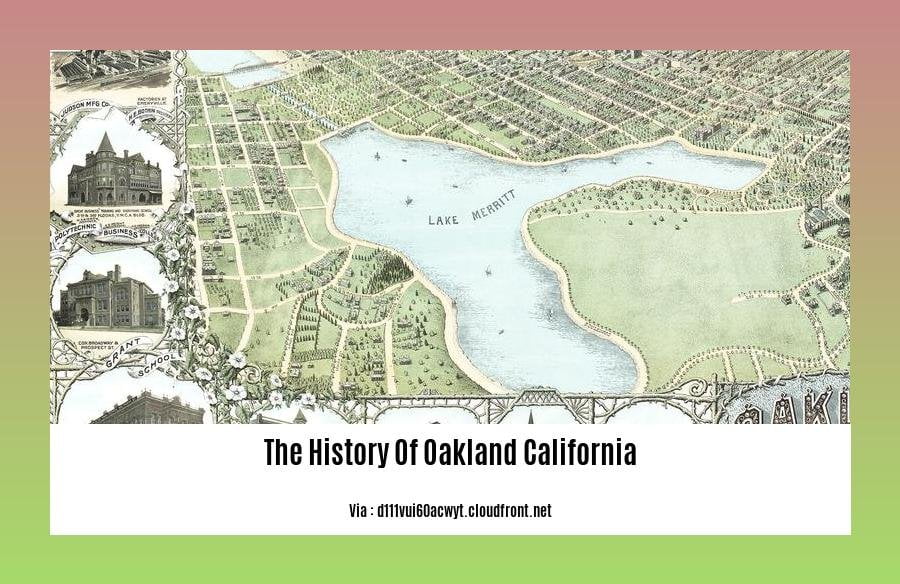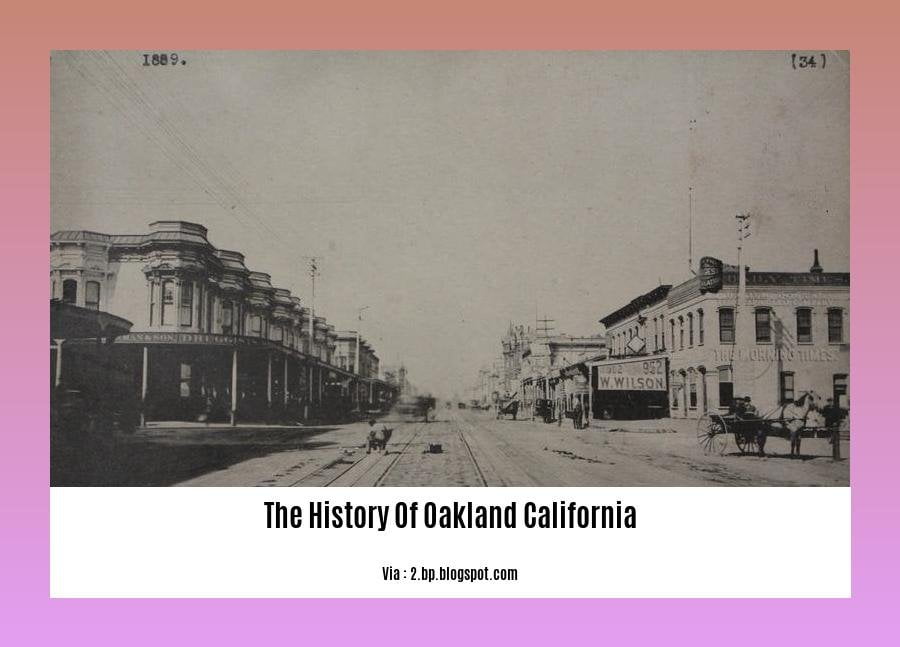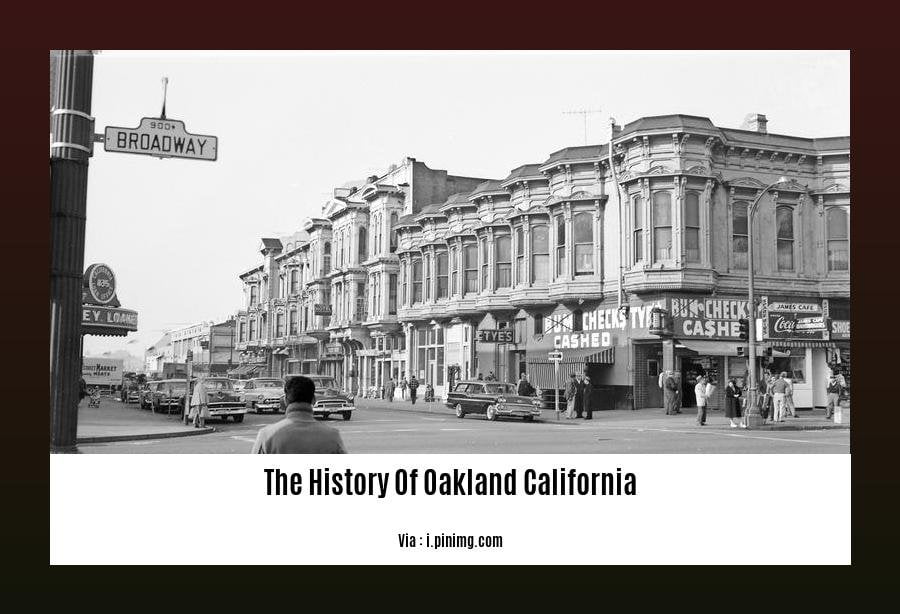Embark on an enriching journey through time as we unveil the captivating history of Oakland, California, in our comprehensive article [- Oakland, California: A Journey Through Time [The History Of Oakland California]]. From its humble beginnings as a small settlement to its rise as a thriving metropolis, discover the stories of remarkable people, iconic landmarks, and transformative events that have shaped this vibrant city.
Key Takeaways:
Oakland, California is a charter city with a rich history and diverse culture, incorporated on May 4, 1852.
The region was originally home to the Costanoan Indians and was explored by the Spanish in the late 18th century.
Rancho San Antonio, a Spanish land grant, was established in the area in 1820.
In the 1840s, logging started in the area, and during the Gold Rush in 1849, Oakland became a transit hub for goods and people.
Its territory included coastal prairie, oak woodland, and north coastal scrub habitats.
After the devastating 1906 San Francisco earthquake, numerous San Francisco inhabitants moved to Oakland, leading to population increase, housing expansion, and improved infrastructure.
With its busy port, shipyards, and thriving automobile manufacturing industry, Oakland continued to prosper in the 20th century.
The History Of Oakland California

Oakland, California, a city steeped in history and charisma, beckons us on a journey through time. From its humble beginnings as a small settlement nestled amidst rolling hills, Oakland’s story is a saga of transformation, resilience, and boundless spirit.
A Tapestry of Cultures and Endeavors
The land now known as Oakland was once home to the Costanoan Indians, who lived in harmony with nature’s embrace. In the 18th century, Spanish explorers ventured into this verdant realm, leaving behind a legacy of land grants and missions. The 1840s witnessed the arrival of loggers, their saws carving paths through the dense forests, while the Gold Rush of 1849 propelled Oakland into a transit hub, bustling with prospectors and fortune seekers.
From Humble Hamlet to Thriving City
Incorporated in 1852, Oakland’s trajectory soared, fueled by its strategic location and diverse industries. Its port bustled with maritime activity, shipyards hummed with the energy of shipbuilding, and automobile factories churned out vehicles that carried dreams across the nation. Oakland’s resilience shone brightly in the aftermath of the devastating 1906 San Francisco earthquake, as it welcomed an influx of residents seeking solace and new beginnings. Its population swelled, its housing stock expanded, and its infrastructure underwent a transformative renewal.
Milestones and Personalities that Shaped a City
Over the decades, Oakland’s story unfolded like a tapestry woven with threads of innovation, activism, and triumph. It became a hub for civil rights movements, a melting pot of cultures, and a birthplace of artistic expression. Its streets echoed with the footsteps of iconic figures, from labor leaders and social reformers to visionaries who shaped the city’s destiny.
Oakland Today: A Vibrant Tapestry of Past and Present
Contemporary Oakland stands as a testament to its rich history, a city that embraces its diverse heritage while propelling itself into the future. Its landmarks, museums, and historical sites invite us to delve into its captivating past, while its thriving arts scene, culinary delights, and vibrant communities showcase its dynamic spirit.
In Oakland’s story, we find inspiration, resilience, and a deep appreciation for the passage of time. It’s a city where yesterday’s echoes resonate in today’s endeavors, where the past and the present intertwine to create a tapestry of enduring beauty and significance.
Want to know the fascinating journey of Oakland from its inception to the present day? Dive into the annals of time and uncover the pivotal moments that shaped this vibrant city. history of oakland timeline
Intrigued by the visionary minds behind Oakland University? Embark on an enlightening journey to discover the individuals who laid the foundation for this prestigious institution and shaped its remarkable legacy. Who Founded Oakland University
Curious about the origins of Oakland? Delve into the tapestry of history and explore the circumstances that led to the establishment of this dynamic city, unveiling the turning points that shaped its identity. When Was Oakland Established
Wondering about the fate of Oakland? Unravel the tale of transformation and renewal, tracing the events that reshaped the city’s landscape and propelled it into a new era of progress and prosperity. What Happened To Oakland
Establishment of Oakland and Early Development

Wandering through the streets of Oakland, I am always pulled back in time to the city’s fascinating beginnings. Once home to the Ohlone people, their rich cultural heritage weaves through the fabric of Oakland’s history like golden threads. Spanish explorers later arrived, leaving their mark on the land.
In the 19th century, Oakland’s destiny took a turn. With the arrival of gold-seekers and adventurous loggers, the city began to flourish. Its strategic location and thriving industries propelled Oakland onto a path of remarkable growth.
Key Takeaways:
Oakland’s roots are intertwined with the Ohlone people, the original inhabitants of the land.
Spanish explorers ventured into Oakland, leaving their印记on the region’s history.
The Gold Rush era ignited Oakland’s growth, attracting prospectors and loggers.
Oakland’s strategic location and burgeoning industries fueled its rapid expansion.
Citations:
Oakland’s History
Civil Rights and Social Justice Movements
While Oakland today is known for its thriving arts scene, diverse culinary delights, and a vibrant community, a chapter in its history is etched with the struggles and triumphs of the Civil Rights and Social Justice Movements. The city has long been at the forefront of the fight for equality and justice, with deep roots that run back to the 19th century.
During the 1960s, Oakland witnessed massive demonstrations and civil unrest. This culminated in the passage of the Civil Rights Acts, which made racial discrimination a federal crime. The city also became a hub for civil rights organizations, including the Black Panther Party.
Oakland’s history of activism and resistance continues to inspire contemporary social justice movements. The city’s landmarks, such as the Seventh Street Corridor, serve as reminders of its Black history and the fight for civil rights. The city’s legacy of defiance and progress has shaped its identity and continues to influence its present struggles.
Key Takeaways:
- Civil Rights and Social justice Movements have deep roots in Oakland’s history, especially from the 19th century onward.
- The 1960s were marked by massive demonstrations, civil unrest, and the passing of the Civil Rights Acts.
- The city was a hub for civil rights organizations, including the Black Panther Party, which played a pivotal role in advocating for equality and justice.
- Oakland’s landmarks like the Seventh Street Corridor stand as reminders of its historic Black history and the fight for civil rights.
- The city’s legacy of activism and resistance continues to shape its identity and inspire contemporary social justice movements.
Sources:
Oakland’s Civil Rights History: A Timeline
The Black Panther Party in Oakland: A History of Resistance and Liberation
Arts, Culture, and Landmarks: Oakland’s Tapestry of Creativity and Heritage
As an avid explorer of Oakland’s rich and diverse cultural heritage, let me take you on a journey to discover the kaleidoscope of arts, culture, and iconic landmarks that make this city a captivating destination.
A City of Creativity and Expression
Oakland’s vibrant arts scene reflects the city’s diverse population and its commitment to artistic expression. From the colorful murals that adorn the city’s walls to the thriving performing arts community, Oakland is a hub of creativity and innovation.
Cultural Crossroads – Blending History and Heritage
A tapestry of cultures and traditions has woven Oakland’s unique identity. The city’s cultural heritage is reflected in its many museums, art galleries, and festivals. The renowned Oakland Museum of California (OMCA) stands as a testament to the state’s rich history, natural landscapes, and cultural diversity.
Landmarks – The Pillars of Oakland’s Identity
Oakland’s historic landmarks serve as anchors of its past, telling the story of the city’s evolution. The iconic Heinold’s First and Last Chance Saloon, a vestige of the Gold Rush era, stands as a reminder of Oakland’s frontier spirit. The Alameda County Title Insurance Co. Building, a stunning example of Art Deco architecture, speaks to the city’s architectural heritage.
Key Takeaways:
- Oakland’s vibrant arts scene offers a kaleidoscope of creative expressions, from captivating murals to thriving performing arts venues.
- The city’s cultural heritage shines through its diverse museums, art galleries, and festivals, celebrating the rich tapestry of traditions and stories that make Oakland unique.
- Oakland’s iconic landmarks stand as anchors of its past, telling the story of the city’s evolution, from the Gold Rush era to the rise of modern architecture.
Sources:
Visit Oakland: Oakland Museums
Visit Oakland: Cultural Arts
FAQ
Q1: Besides logging, what other industries contributed to Oakland’s growth in the 19th century?
A1: Oakland’s growth in the 19th century was also fueled by its busy port, shipyards, and a thriving automobile manufacturing industry.
Q2: What were the long-term effects of the 1906 San Francisco earthquake on Oakland?
A2: Following the devastating earthquake, many San Francisco residents relocated to Oakland, leading to a surge in population, increased housing development, and improved infrastructure.
Q3: How did Oakland’s diverse cultural heritage manifest itself in the city’s art and culture?
A3: Oakland’s cultural diversity is reflected in the more than 100 languages spoken in the city, which find artistic expression in various mediums throughout the city.
Q4: What are some of the notable historical landmarks that visitors can explore in Oakland?
A4: Prominent historical landmarks in Oakland include Heinold’s First and Last Chance Saloon, Alameda County Title Insurance Co. Building, and Joaquin Miller Park, among others.
Q5: What is the significance of the Black Panther Party in Oakland’s history?
A5: Founded in Oakland in 1966, the Black Panther Party played a pivotal role in advocating for civil rights and Black liberation, leaving a lasting impact on the city’s history and social landscape.









